Snakes have been on this planet for at least 150 million years. Snakes have served as a deadly predator for humans, a threat to our livestock, and a danger even when we aren’t preyed on thanks to the venom some species carry. But snakes play a valuable role in maintaining pest populations, and the modern snake is almost always more of a nuisance to humans than it is a direct and immediate danger to our lives.
You can keep snakes away from your home without having to employ deadly methods like shooting or poisoning them, which can also potentially be dangerous to yourself, pets, or wildlife that’s helpful to your local ecosystem. What keeps snakes away? Here are 10 prevention methods you can use to keep snakes away from your property while still maintaining the natural order.
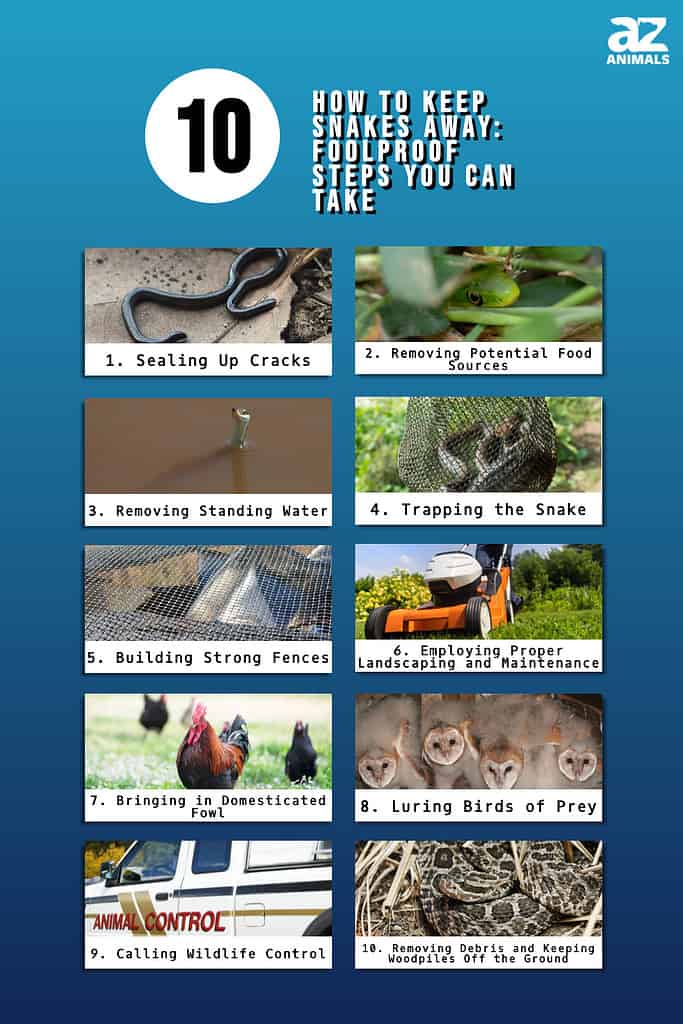
1. Sealing Up Cracks

Snakes may get into the home along with potted plants, or come in from outside by crawling under doors or through cracks.
©Patrick K. Campbell/Shutterstock.com
Snakes in your yard are one thing, but an infestation within your house is another threat entirely. The best approach to prevention is to keep them from having access in the first place. Finding access points for snakes means thinking like a snake. These serpents have a particular fondness for crawlspaces that are warm and damp, so you’ll want to check around the perimeter of your home for any cracks or holes that might exist near ground level or in the foundation.
Storm drains can similarly offer access points to snakes, and you can extend your search to the sidewalk surrounding your home if you’re still dealing with the threat of an infestation. Making this a semi-regular part of your home maintenance can help not just keep them away but also serve as a prevention method to keep pests like raccoons, mice, and opossums from your home.
2. Removing Potential Food Sources

Snakes seek food and shelter. Remove those items and they’re not likely to visit.
©iStock.com/Shoemcfly
The efficacy of repellents like fox urine, garlic, and lemongrass are largely anecdotal, but you can more effectively keep snakes away from your property by removing their reason for visiting in the first place. Snakes are predators and seek shelter and food. So, if a snake is venturing onto your property, there’s a good chance that they’re hunting for food. If they stay, there’s a high probability it’s because your yard affords a dependable food source. Bird feeders are especially attractive to snakes because they attract potential meals in the form of birds but also because seeds that have either been dropped by birds or spilled when filling the feeder can lure in rodents and insects which snakes can then hunt.
If you feed your cat or dog outdoors, that could also draw in rodents and bring snakes along with them. Move the pet bowl inside, and be sure to thoroughly seal any containers with birdseed.
3. Removing Standing Water
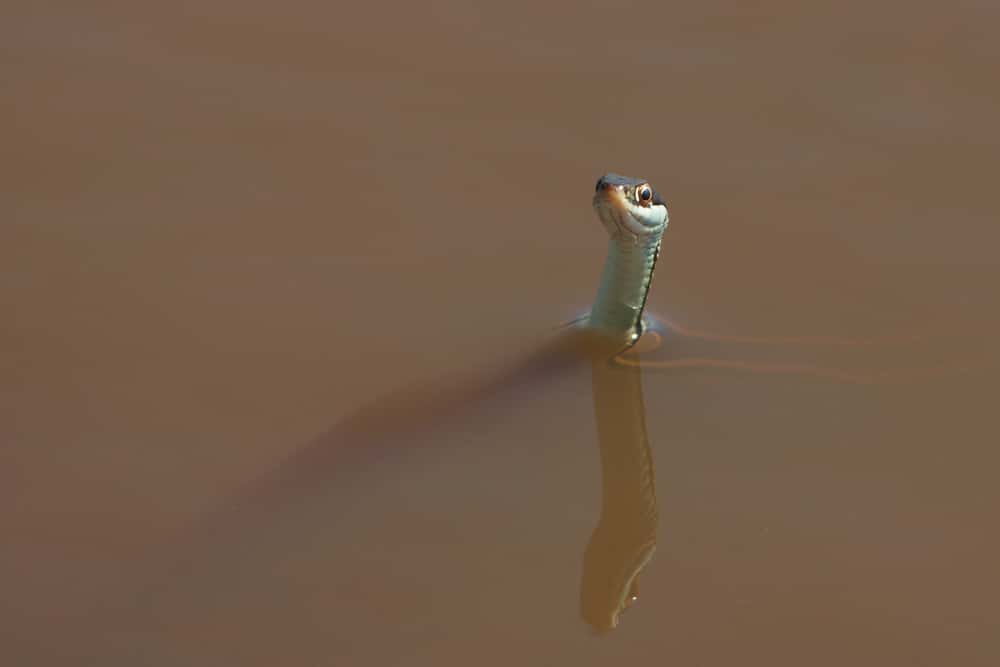
Standing water can attract frogs, insects, small mammals, and snakes.
©Scott Payne/Shutterstock.com
Standing water tends to build a pretty diverse ecosystem, and that includes insects, frogs, and small mammals that are often the preferred prey of snakes. Making sure that any pool in your yard is properly treated can prevent snakes and other animals from establishing a community on your lawn, and snakes are also often drawn to the poolside because they like to sunbathe on concrete.
Although there’s nothing proven, some anecdotal evidence suggests that ammonia or white vinegar placed around water sources can keep snakes away, but your surest bet is to reduce standing water sources as much as possible. Keep an eye out for parts of the lawn that gather standing water after heavy rainfall, and consider reducing the number of times you water your lawn if you’ve begun to notice snakes on your property.
4. Trapping the Snake
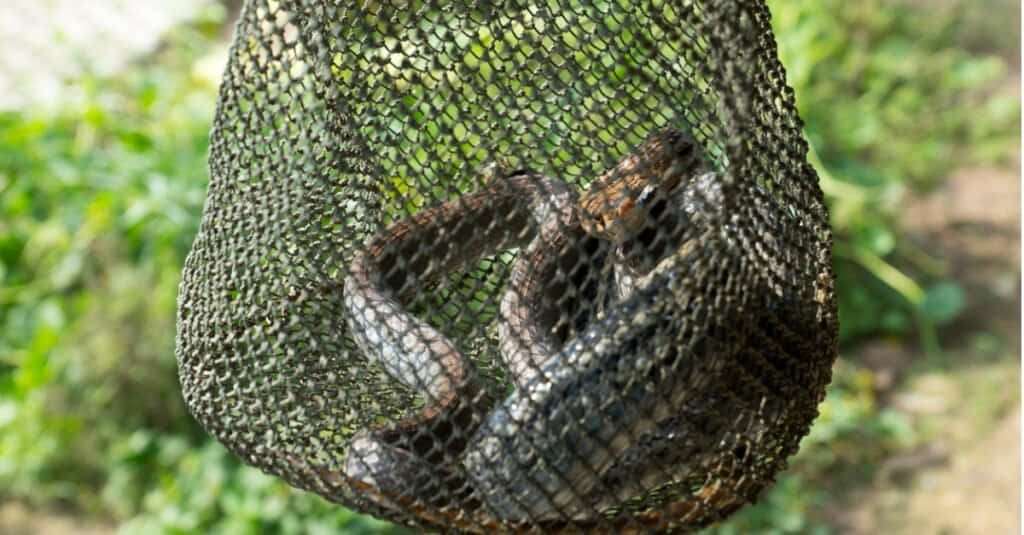
Using mesh is a great option for catching snakes.
©Tuttoo/Shutterstock.com
Trapping won’t do you much good if you have a larger infestation of snakes, but it can be very effective if you know that you simply have one troublemaker under your house or on the lawn. Traps can be bought at your local hardware store, and you should only use a professional trap rather than trying to make one yourself. This is especially true if you aren’t sure whether or not the snake could be venomous. Eggs are a common choice of bait because snakes don’t eat carrion, and live bait can be hard to deal with. Be sure to relocate the snake at least two miles — but ideally five or six — from your home so that it won’t simply return.
5. Building Strong Fences

Certain types of fences are built to keep out wild animals such as snakes. Preferred materials are vinyl fencing or tight wire mesh.
©John Cumbow/Shutterstock.com
If your fence isn’t preventing a snake infestation — or if you don’t have any fence at all — it might be time for an upgrade. The unique physiology of snakes means that you’ll need to seek out fencing materials and employ techniques that can prevent them from just slithering through. The generally recognized height for a fence that will effectively keep snakes away is three feet, and there are two potential choices for materials. Vinyl fencing is a sheer option that snakes can neither climb over nor through, and tight mesh wire can be both effective and cheap as long as it’s positioned at an angle. In either case, you’re going to want to make sure that the fencing itself is buried at least half a foot into the ground.
Having a professional install snake fencing can reduce the number of snakes that enter your yard. However, snakes can climb — trees, bushes, and shrubs are all easy ladder material for them to get over any fence.
6. Employing Proper Landscaping and Maintenance
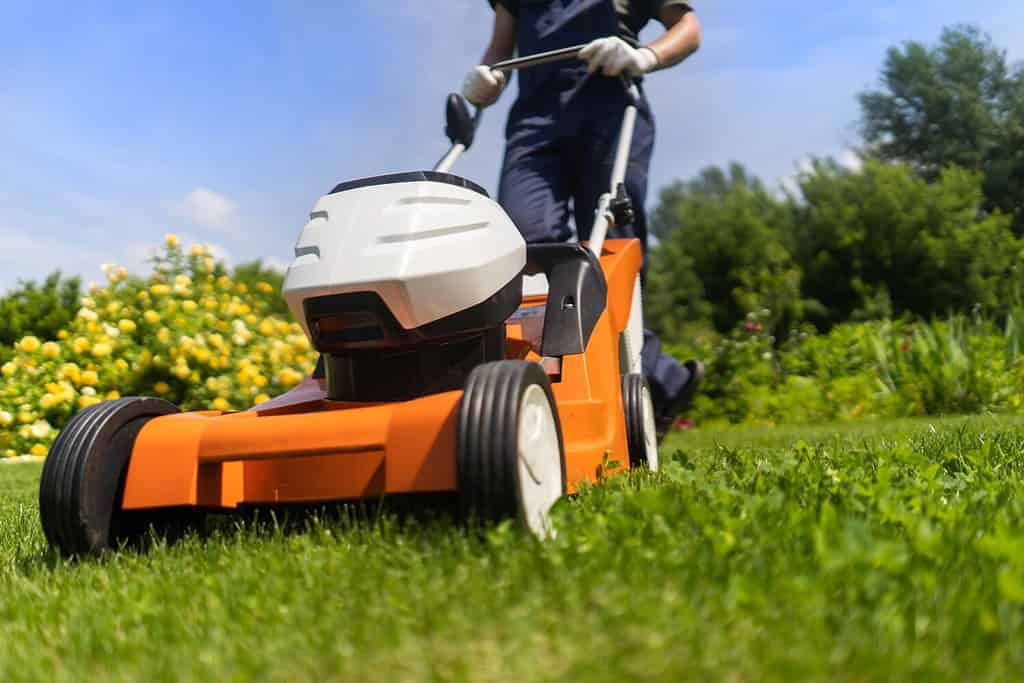
Maintaining the landscaping around your home can help cut back on snake intruders.
©africa_pink/Shutterstock.com
If it’s been a while since you’ve done any maintenance on your lawn, you could be fostering an environment that attracts snakes. Taller grass provides a habitat for creatures like slugs and rabbits while also offering great cover for a hunting snake. You can also benefit from diligently trimming your shrubs, bushes, and trees. Maintaining a clearance of two to three feet underneath shrubs will reduce the amount of space where snakes can hide, and it can make sure that they’re more visible to you when they do appear.
Special attention should be paid to trees or shrubs that snakes could use to crawl over fencing. If you’re using rocks in your landscaping, it’s generally advised that you opt for smaller rocks, pebbles, and gravel. Larger rocks and the spaces between them tend to be popular hiding and nesting spots for snakes.
7. Bringing in Domesticated Fowl

Believe it or not, domestic fowl like chickens are capable of managing snake populations, especially roosters, who protect hens and chicks from danger.
©cynoclub/Shutterstock.com
It might seem counterintuitive to invite chickens into your yard considering that eggs are a tasty meal for snakes, but domesticated fowl are at least as unhappy as you to invite snakes into their home. Chickens can be a good choice for managing the populations of small snakes, as they’ll hunt more meager serpents they spot instinctively. Roosters in particular will seek out snakes that could threaten local hens and eggs.
If you’re looking for some fowl that are more effectively specialized in killing snakes, you can always bring a turkey or a guinea fowl into your yard. The latter in particular is known to actively seek out and kill smaller snakes. Just keep in mind that venomous species like rattlesnakes and water moccasins can pose a threat to even your largest domesticated birds.
8. Luring Birds of Prey
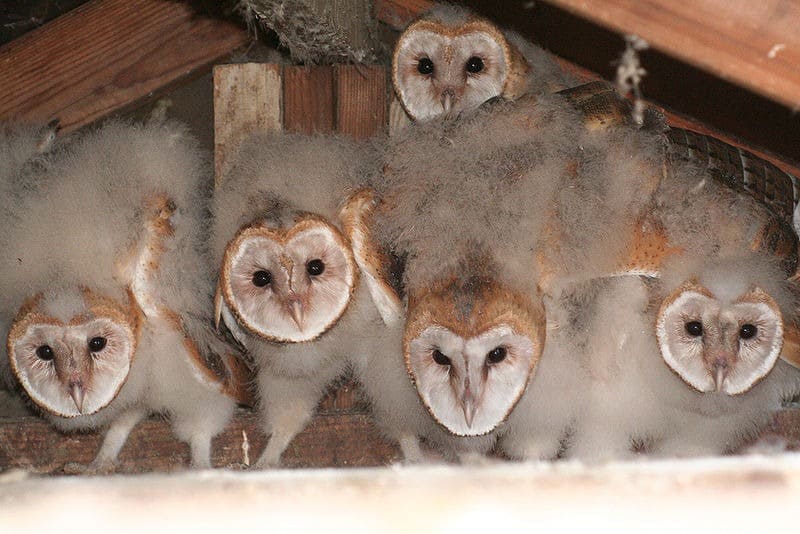
Birds of prey like owls target snakes for a tasty meal. Making them feel at home on your property can be beneficial.
What keeps snakes away? Predators. Snakes are a favored snack for most owl species, and luring them onto your property can serve as an effective way to control both snake and rodent populations on your property. Most hardware stores sell statues that look like owls and are designed to scare snakes off, but there’s little evidence that these methods fool snakes. Growing trees with strong branches high up can help transform your lawn into a popular hunting site for owls, and you can also buy or build a nesting box to offer even more attraction.
What owls — or other birds of prey — you can lure and how effective they’ll be will depend on where you live. In rare cases, great horned owls have been known to attack small dogs and cats, so you’ll want to be sure that you understand the local ecology before doing anything.
9. Calling Wildlife Control

When all else fails, you can always give animal control a call to help rid your yard or house of an unwelcome snake.
©Jim Parkin/Shutterstock.com
If your snake situation is too much to handle or you’re worried that there might be a poisonous species in your lawn, it might be time to call a specialist. The issue might be handled by the fire department, police department, or animal control depending on your local government, and some private contractors can help you. If at all possible, try and safely take a picture of any snake you see so the professionals can better understand what they’re dealing with.
10. Removing Debris and Keeping Woodpiles Off the Ground
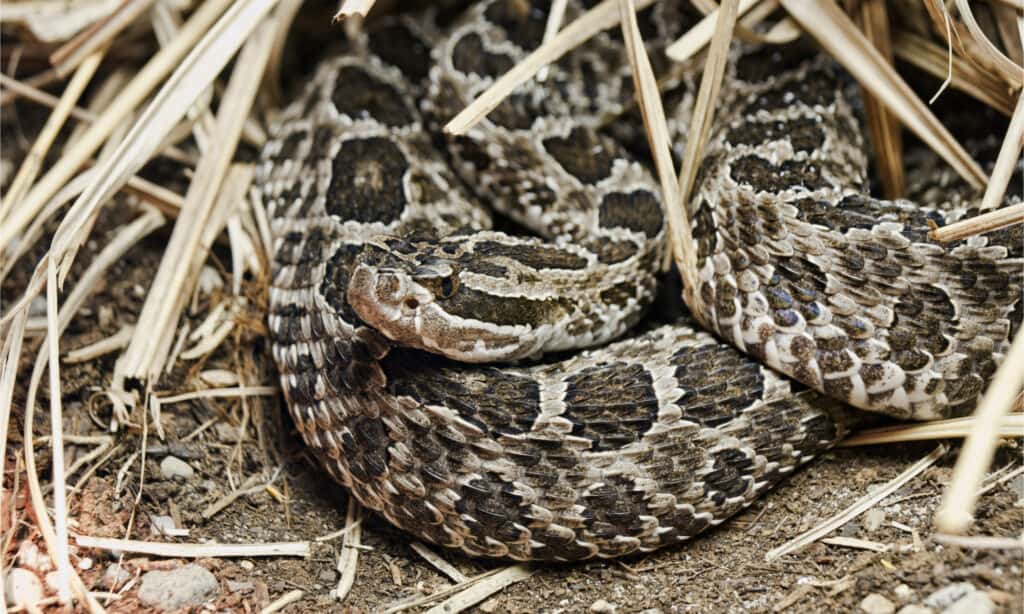
Snakes enjoy hiding amongst debris, tall grass, and even in wood piles.
©DnDavis/Shutterstock.com
The bottom line for keeping snakes out of your yard is to remove the things that attract them in the first place. They love hiding in nooks and crannies provided by piles of debris and even your firewood pile.
Keeping your firewood off the ground at least a foot will help minimize the attraction.
Summary of Ways to Get Rid of Snakes
List of Ways to Get Rid of Snakes
Our research shows that 10 foolproof ways to get rid of snakes are as follows:
| Rank | Remedies |
|---|---|
| 1 | Sealing up cracks |
| 2 | Reoving potential food sources |
| 3 | Removing standing water |
| 4 | Trapping the snake |
| 5 | Building strong fences |
| 6 | Employing proper landscaping and maintenance |
| 7 | Bringing in domesticated fowl |
| 8 | Luring birds of prey |
| 9 | Calling Wildlife Control |
| 10 | Removing debris and keeping woodpile off the ground |
The photo featured at the top of this post is © Rini Kools/Shutterstock.com
Discover the "Monster" Snake 5X Bigger than an Anaconda
Every day A-Z Animals sends out some of the most incredible facts in the world from our free newsletter. Want to discover the 10 most beautiful snakes in the world, a "snake island" where you're never more than 3 feet from danger, or a "monster" snake 5X larger than an anaconda? Then sign up right now and you'll start receiving our daily newsletter absolutely free.
Thank you for reading! Have some feedback for us? Contact the AZ Animals editorial team.






